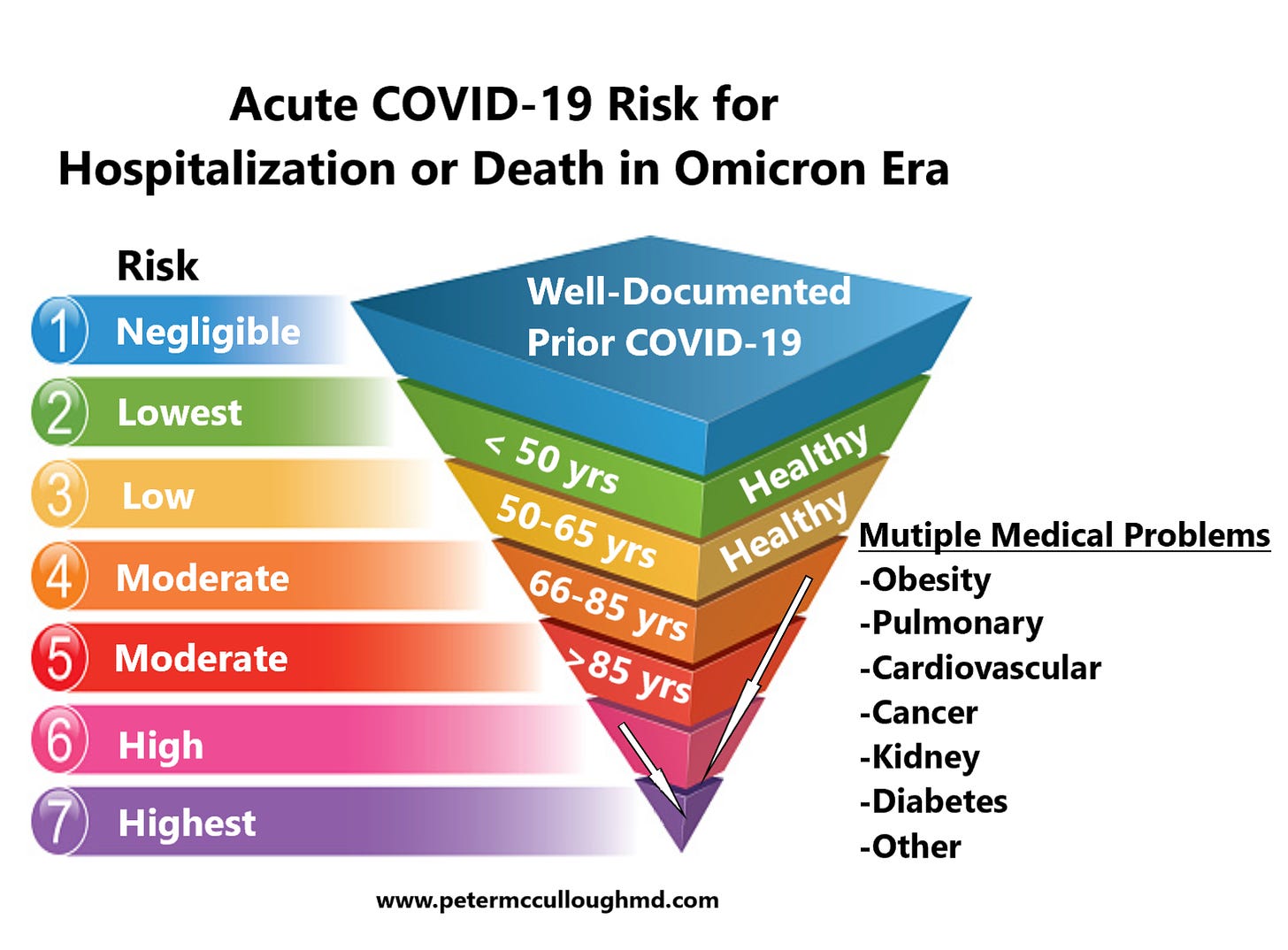Far and away the most common questions I receive from followers deal with the issue of acute SARS-CoV-2 viral infection termed COVID-19 illness. The reason why myself and several other leading doctors prioritized the ambulatory phase of the illness was driven by the observation that the primary endpoint of interest was hospitalization and death. Since most deaths were occurring in the hospital, the prevention of hospitalization largely would be a strategy to improve both outcomes and allow community-dwelling individuals to survive the illness much like any other viral upper respiratory tract illness in the comfort of their homes. This stack gives an opportunity to lay out the McCullough Protocol© in a referenceable series available to the public.[i] [ii] At the very top of the protocol is the quick clinical process of “risk stratification” specifically indicating the risk for hospitalization and death which is not the same for every person. Additionally, SARS-CoV-2 has substantially mutated through strains: Wuhan wild-type, Alpha, Beta, Gamma, Delta, and Omicron. At the advent of Omicron, the infection became considerably less virulent. Omicron, however, was the first strain that broke through natural immunity in large numbers creating the opportunity for second and third episodes of COVID-19. Dr. McCullough has been following his patients carefully in practice and communicating with physicians around the world and their collective observations are cohesive with emerging scientific data with some good news: successive COVID-19 infections are progressively milder. In other words, the natural immunity gained from the first or index infection is protective against severe outcomes with the next infection. Chemaitelly and colleagues have reported 97% protection against hospitalization and death with natural immunity with no waning of protection over time.[iii] Thus, the most important risk stratifier is well-documented prior infection. After that, the conventional risk factors for severe infection can be integrated in any one of the risk calculators.[iv] These factors in approximate descending importance include: age, obesity, lung disease, heart disease, cancer, kidney disease, diabetes, and other chronic illnesses and conditions.
When evaluating a manuscript on COVID-19 outcomes for example with vaccination, look in the table of baseline characteristics (usually Table 1) and see if the authors have disclosed whether or not patients have had a prior episode of COVID-19. You will be shocked how many manuscripts have been published during the Omicron era without disclosing prior infection as the most important baseline variable. Unfortunately, most of these papers are rendered invalid based on unaccounted confounding. For example, one cannot conclude vaccines or boosters or any other intervention makes COVID-19 “milder” unless the study is randomized or otherwise handles the important confounder of natural immunity.
In stacks to follow, the intensity and duration of treatment for COVID-19 in the McCullough Protocol© will described according to the risk of hospitalization and death. As a general rule for those initially presenting with mild symptoms, for second and third infections are indistinguishable from the common cold and it is rare that prescription medications are needed provided prompt over-the-counter agents are deployed. In summary, receiving the next call on acute COVID-19, the first question to ask is: “Is this the first episode of COVID-19, or have you had it before?” If your doctor, employer, school, or military health office is not asking this question—be sure to bring it up and have it documented in the medical record.
[i] McCullough PA, Kelly RJ, Ruocco G, Lerma E, Tumlin J, Wheelan KR, Katz N, Lepor NE, Vijay K, Carter H, Singh B, McCullough SP, Bhambi BK, Palazzuoli A, De Ferrari GM, Milligan GP, Safder T, Tecson KM, Wang DD, McKinnon JE, O'Neill WW, Zervos M, Risch HA. Pathophysiological Basis and Rationale for Early Outpatient Treatment of SARS-CoV-2 (COVID-19) Infection. Am J Med. 2021 Jan;134(1):16-22. doi: 10.1016/j.amjmed.2020.07.003. Epub 2020 Aug 7. PMID: 32771461; PMCID: PMC7410805.
[ii] McCullough PA, Alexander PE, Armstrong R, Arvinte C, Bain AF, Bartlett RP, Berkowitz RL, Berry AC, Borody TJ, Brewer JH, Brufsky AM, Clarke T, Derwand R, Eck A, Eck J, Eisner RA, Fareed GC, Farella A, Fonseca SNS, Geyer CE Jr, Gonnering RS, Graves KE, Gross KBV, Hazan S, Held KS, Hight HT, Immanuel S, Jacobs MM, Ladapo JA, Lee LH, Littell J, Lozano I, Mangat HS, Marble B, McKinnon JE, Merritt LD, Orient JM, Oskoui R, Pompan DC, Procter BC, Prodromos C, Rajter JC, Rajter JJ, Ram CVS, Rios SS, Risch HA, Robb MJA, Rutherford M, Scholz M, Singleton MM, Tumlin JA, Tyson BM, Urso RG, Victory K, Vliet EL, Wax CM, Wolkoff AG, Wooll V, Zelenko V. Multifaceted highly targeted sequential multidrug treatment of early ambulatory high-risk SARS-CoV-2 infection (COVID-19). Rev Cardiovasc Med. 2020 Dec 30;21(4):517-530. doi: 10.31083/j.rcm.2020.04.264. PMID: 33387997.
[iii] Protection of prior natural infection compared to mRNA vaccination against SARS-CoV-2 infection and severe COVID-19 in Qatar Hiam Chemaitelly, Houssein H. Ayoub, Sawsan AlMukdad, Peter Coyle, Patrick Tang, Hadi M. Yassine, Hebah A. Al-Khatib, Maria K. Smatti, Mohammad R. Hasan, Zaina Al-Kanaani, Einas Al-Kuwari, Andrew Jeremijenko, Anvar Hassan Kaleeckal, Ali Nizar Latif, Riyazuddin Mohammad Shaik, Hanan F. Abdul-Rahim, Gheyath K. Nasrallah, Mohamed Ghaith Al-Kuwari, Adeel A. Butt, Hamad Eid Al-Romaihi, Mohamed H. Al-Thani, Abdullatif Al-Khal, Roberto Bertollini, Laith J. Abu-Raddad medRxiv 2022.03.17.22272529; doi: https://doi.org/10.1101/2022.03.17.22272529
[iv] Cleveland Clinic Risk Calculator for COVID-19 Hospitalization





